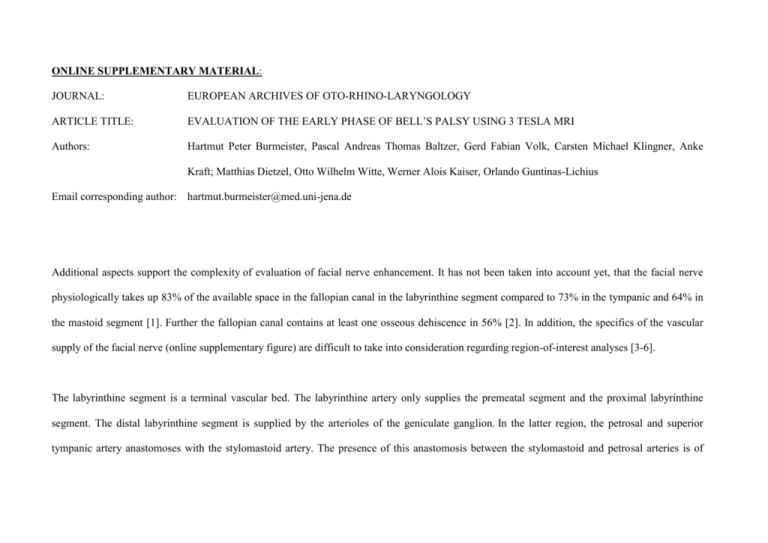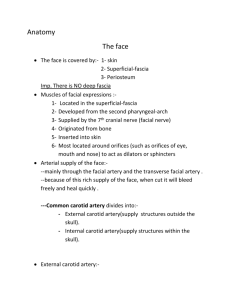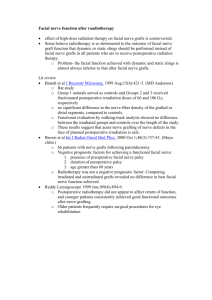Online supplementary material: Journal: European Archives of Oto
advertisement

ONLINE SUPPLEMENTARY MATERIAL: JOURNAL: EUROPEAN ARCHIVES OF OTO-RHINO-LARYNGOLOGY ARTICLE TITLE: EVALUATION OF THE EARLY PHASE OF BELL’S PALSY USING 3 TESLA MRI Authors: Hartmut Peter Burmeister, Pascal Andreas Thomas Baltzer, Gerd Fabian Volk, Carsten Michael Klingner, Anke Kraft; Matthias Dietzel, Otto Wilhelm Witte, Werner Alois Kaiser, Orlando Guntinas-Lichius Email corresponding author: hartmut.burmeister@med.uni-jena.de Additional aspects support the complexity of evaluation of facial nerve enhancement. It has not been taken into account yet, that the facial nerve physiologically takes up 83% of the available space in the fallopian canal in the labyrinthine segment compared to 73% in the tympanic and 64% in the mastoid segment [1]. Further the fallopian canal contains at least one osseous dehiscence in 56% [2]. In addition, the specifics of the vascular supply of the facial nerve (online supplementary figure) are difficult to take into consideration regarding region-of-interest analyses [3-6]. The labyrinthine segment is a terminal vascular bed. The labyrinthine artery only supplies the premeatal segment and the proximal labyrinthine segment. The distal labyrinthine segment is supplied by the arterioles of the geniculate ganglion. In the latter region, the petrosal and superior tympanic artery anastomoses with the stylomastoid artery. The presence of this anastomosis between the stylomastoid and petrosal arteries is of profound functional significance since it ensures adequate vascular supply of the intracanalicular segment of the facial nerve, even after obstruction of one or another of its component vessels [7]. Other known variations of vascularization that have been reported are duplications of blood vessels at the tympanal segment [5], a persistent stapedial artery [8], or a persistent lateral capital vein [9] occasionally accompanying the facial nerve in the Fallopian canal. ONLINE SUPPLEMENTARY REFERENCES 1. May M (2000) Anatomy for the Clinician. In: May M, Schaitkin BM (eds) The facial nerve. vol May´s 2nd, May´s 2nd edn. Thieme, New York, pp 19-56 2. Moreano EH, Paparella MM, Zelterman D, Goycoolea MV (1994) Prevalence of facial canal dehiscence and of persistent stapedial artery in the human middle ear: a report of 1000 temporal bones. Laryngoscope 104 (3 Pt 1):309-320 3. Balkany T, Fradis M, Jafek BW, Rucker NC (1991) Intrinsic vasculature of the labyrinthine segment of the facial nerve--implications for site of lesion in Bell's palsy. Otolaryngol Head Neck Surg 104 (1):20-23 4. Leblanc A (2001) Facial Nerve. In: Leblanc A (ed) Encephalo-peripheral nervous System: vascularisation, anatomy, imaging. Softcover edn. SpringerVerlag, Berlin Heidelberg New York, pp 229-324 5. Minatogawa T, Kumoi T, Hosomi H, Kokan T (1980) The blood supply of the facial nerve in the human temporal bone. Auris Nasus Larynx 7 (1):7-18 6. Ogawa A, Sando I (1982) Spatial occupancy of vessels and facial nerve in the facial canal. Ann Otol Rhinol Laryngol 91 (1 Pt 1):14-19 7. Blunt MJ (1956) The possible role of vascular changes in the aetiology of Bell's palsy. J Laryngol Otol 70 (12):701-713 8. Silbergleit R, Quint DJ, Mehta BA, Patel SC, Metes JJ, Noujaim SE (2000) The persistent stapedial artery. AJNR Am J Neuroradiol 21 (3):572-577 9. Nager GT, Proctor B (1991) Anatomic variations and anomalies involving the facial canal. Otolaryngol Clin North Am 24 (3):531-553 ONLINE SUPPLEMENTARY FIGURE Schematic drawing of anatomical structures and vascular supply of a (1) anterior inferior cerebellar artery, left sided facial nerve in the internal auditory canal and facial canal. (2) labyrinthine artery, (3) trifurcation of anterior vestibular, common cochlear, and vestibulocochlear artery, (4) labyrinthine segment with vascular supply from 3+7, (5) petrosal artery accompanying the greater superficial petrosal nerve, (6) superior tympanic artery accompanying the lesser superficial petrosal nerve leaving the Fallopian canal at the geniculate ganglion or tympanal segment, (7) profuse, fine arterial network in the geniculate body, (8) circumnerval arterial plexus from the stylomastoid artery in the tympanal and proximal mastoidal segment, (9) stylomastoid artery in the distal mastoidal segment, and (10) venous plexus in the distal internal auditory canal. A = anterior, L = left, P = posterior, R = right









